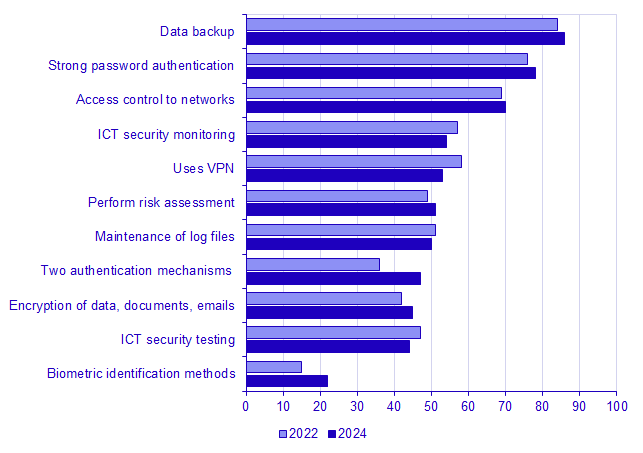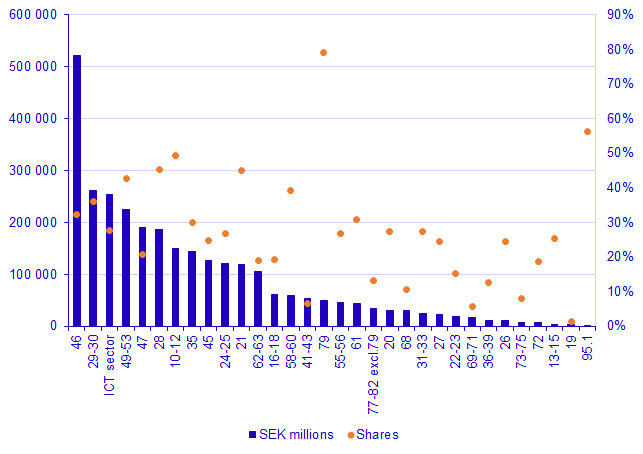ICT usage in enterprises, 2024
Large increase in the use of AI in enterprises 2024
Statistical news from Statistics Sweden 2024-11-21 8.00
During 2024, the use of artificial intelligence (AI) in enterprises more than doubled compared to 2023. New statistics from the survey ICT Usage in Enterprises also show that the share of enterprises employing ICT specialists decreased and the application of ICT security measures increased during 2024.
The access to, and user friendliness of, AI technologies improves continuously and since 2023, the development has been rapid. The use of AI technologies among enterprises with 10 or more employees increased from 10.4 percent in 2023 to 25.2 percent in 2024.
Among enterprises using AI in 2024, 69.2 percent stated that they used AI for one or more purposes, leaving the share approximately unchanged since 2023. This means that for more than 30 percent of enterprises, the use of AI serves no explicit purpose. Out of the enterprises that did not use any AI technology, 14.5 percent considered using AI. This was an increase of 6.2 percentage points since 2023.
The most common method of acquisition of AI technology among enterprises was to purchase commercial software or systems ready to use, at 54.6 percent in 2024 compared to 44.5 percent in 2023. Acquiring open-source software or systems that were modified by the enterprise’s own personnel also became more common, increasing by 5.9 percentage points, while the occurrence of the other methods of acquisition either decreased or was unchanged compared to 2023. The increase in AI use means that a larger number of enterprises responded to the question on acquisition methods in 2024 compared to 2023. Therefore, changes over time should be interpreted with caution.

For a more in-depth analysis of AI use in enterprises, policy goals relating to AI, and occupational groups which play a crucial role in realising the advantages of AI, see AI Use in Enterprises. The report also includes a discussion of the concept of “AI use” as an indicator by combining enterprise and household statistics in an explorative microdata analysis.
Decreasing share of enterprises employs ICT specialists
During 2024, 21.6 percent of enterprises employed ICT specialists. This was a decrease by 1.4 percentage points in comparison to 2022.
During 2023, 10.1 percent of enterprises either recruited or tried to recruit ICT specialists. Compared to 2021, this was a decrease of 1.9 percentage points. Among these enterprises, 53.0 percent experienced problems with recruiting ICT specialists, which in turn was a decrease of 8.9 percentage points.
The most frequently experienced problem when recruiting ICT specialists in 2023 was that the applicants lacked relevant work experience, increasing in frequency by 6.7 percentage points compared to 2021. Second most common was that applicants lacked relevant ICT-related qualifications from education or training, which increased by 4.3 percentage points. During 2021 the most frequently reported reason was a lack of applicants. However, this became less common in 2023 by 11.1 percentage points.

Fewer ICT related security incidents in 2023 and more ICT security measures in 2024
Out of all enterprises, 20.4 percent experienced at least one ICT related security incident which led to consequences in 2023, compared to 21.1 percent in 2021. Among the consequences enterprises experienced as a result of these security incidents were unavailability of ICT services (due to e.g. ransomware attacks, or Denial of Service attacks), destruction or corruption of data, and disclosure of confidential data.
The number of enterprises that took measures in their ICT systems increased in 2024 compared with 2022. Of all enterprises, 92.7 percent took some kind of measure, compared to 90.7 percent in 2022. The most common action was to back up data followed by authentication via strong password. Least common was authentication via biometric methods (such as authentication based on fingerprints, voice recognition, or face recognition). Two-factor authentication increased most in relative frequency between 2022 and 2024 was, by 11.0 percentage points. The most significant decrease concerned the use of VPN (Virtual Private Network), which decreased by 5.0 percentage points.

E-commerce sales (web sales and EDI) in 2023
Turnover from web sales of goods and services (on the enterprises’ own web pages, apps or on e-commerce sites) and from EDI-type sales (Electric Data Interchange) amounted to SEK 2 690 billion in 2023, which corresponds to 26.3 percent of total turnover for enterprises with 10 or more employees. Among enterprises with e-commerce sales, these sales accounted for 13.5 and 19.5 percent of total turnover for small and medium sized enterprises respectively. In large enterprises, e-commerce sales accounted for 32.2 percent of total turnover.
The prevalence of e-commerce sales differed between industries. The most e-commerce intensive industries were Travel agency, tour operator and other reservation service and related activities (SNI 79), Repair of computers and communication equipment (SNI 95.1), and Manufacture of food products, beverages, and tobacco products (SNI 10-12). However, Wholesale trade (SNI 46), the automotive industry (SNI 29-30), and the ICT sector which contains both manufacturing and service industries accounted for the largest volumes of turnover from e-commerce.

Changes in the statistical unit
Ahead of the reference period 2023, changes have been made in the statistical unit enterprise. The number of enterprises with multiple legal units increases in the population, from about 30 enterprises to 50 000. This entails that there are fewer, but larger enterprises. This mitigates problems of double counting for some variables, such as turnover, as internal flows are consolidated. It also causes changes in the population structure concerning industry as well as having effects on size classes and regional reporting of the statistics.
More information can be found on Statistics Sweden’s website.
Changes in the statistical unit has also affected the design of the survey which in turn has effects for the statistics produced. More information on the design can be found in the methodological documentation for the survey. A report concerning the time series break can be read here:
Break in Series. Changes in ICT Usage in Enterprises and Innovation in the Enterprise Sector (pdf)
Comparisons over time should be made sparingly and with caution.
Definitions and explanations
The statistical news only reports on enterprises with 10 or more employees. More information on the statistics, as well as results for other study domains, can be obtained from the Statistical Database on Statistics Sweden’s website.
SNI – Swedish Industrial Classification Standard
The survey reports the following operations according to SNI 2007:
Manufacturing industry – SNI 10–33
Energy and waste-disposal – SNI 35–39
Construction industry – SNI 41-43
Trade; repair establishments for motor vehicles– SNI 45–47
Transportation and storage companies – SNI 49–53
Hotels and restaurants– SNI 55–56
Information and communication companies – SNI 58–63
Real estate companies– SNI 68
Other service companies – SNI 69–74, 77–82, 95.1
ICT-sector – SNI 26.1–26.4, 26.8, 46.5, 58.2, 61–62, 63.1, 95.1
For more information, see SNI.
Production and quality of the statistics
The questionnaire on which the data is based, as well as more information on the statistics, can be found in the documentation on the Production of the Statistics (2022). If you have any questions on the quality of the statistics, please refer to the Quality Declaration of the product (2022). These documents are provided here: ICT-usage in enterprises
Publication
Feel free to use the facts from this statistical news but remember to state Source: Statistics Sweden.
